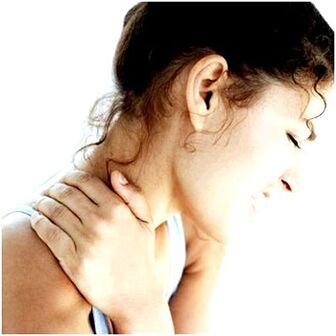
The osteochondrus process affects one of the spine or several at a time.The lumbar and cervical vertebrae are most affected by pathologies, as most susceptible to load due to the anatomy of the human skeleton.
The effects of spinal osteochondrosis in the cervical region cause the most discomfort and potential complications, since the neck is a zone rich in neuromusive highways, many of which feed the brain directly.
For this reason, clinical symptoms with cervical osteochondrosis are very associated with ischemia of the brain areas.In addition, the nerve roots that ensure the sensitivity and motor activity of the hands and the shoulder girdle, when pressed with destroyed spinal animals, can give a variety of symptomatic picture.
Below, think about the General Osteochondrosis Clinic of the cervical spine.
Dizziness
Dizziness is also due to a violation of blood flow to the organs of the inner ear, which guarantees the balance of the body.Nystagma often joins dizziness - arbitrary fluctuations in eye students to the countries.
Air
This sensation occurs due to irritation of the edges of the diaphragmatic nerve.It is a component of the cervical nerve beam and is involved in the regulation of breathing, its depth and frequency.Patients complain about the inability to breathe in the full breast.
In some cases, the symptom worsens to severe shortness of breath and suffocation.For the same reason, breathing stops at night and snore.
The disadvantage of oxygen due to breathing problems is ultimately the cause of increased fatigue, reducing concentration and memory problems.
Nausea
It is accompanied by landing.Also due to blood circulation problems in some areas of the brain and inner ear.Sometimes nausea is observed with unbreakable vomiting provoked by head and body movements.The consequence of frequent nausea and vomiting is a reduction in appetite, weight loss, valuable deficiency.
Vision problems
"Flies" in the eyes, reduction of visual acuity, fog in front of the eyes - these are all symptoms due to ischemia of the brain area responsible for vision.
Patients with osteochondrosis complain more than vision, as the lack of blood supply from the vertebrae is offset by the flow of blood from the carbon arteries system.
Glasses and therapeutic gymnastics for the eye muscles do not solve the problem, usually vision improves after the treatment of osteochondrosis.
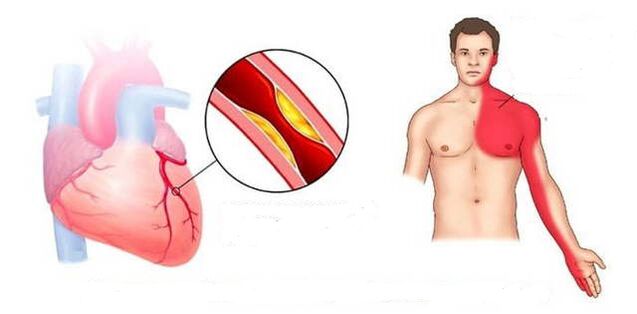
The unstable pressure level is due to impaired blood flow to the elongated brain, which is responsible for the functions of the vascular-motor center.
It occurs with spasm of the arteries of the brain due to the short -term stopping of the blood flow along the spinal arteries.
From the state of loss of the patient's consciousness, you can quickly remove it by placing it so that the legs are slightly higher than the head - blood flow to the brain allows a person to lead to life.
After a fainted attack, reversible problems with speech and movement due to a brief stop of blood flow, they can be observed for some time.
Green symptoms
Often this may be the only sign showing cervical osteochondrosis.They are expressed as sweating, dryness and a lump in the throat, difficulty in swallowing.The symptoms are related to the compression of the nerve plexus responsible for the innervation of the pharynx.It is necessary to distinguish similar manifestations from such a clinic for inflammation or neoplasms.
Increasing body temperature for cervical osteochondrosis is not the most typical symptom, it is rarely and locally observed: in the area of the cervix and collar with a slight redness of the skin.
The clinic of osteochondrosis in the cervical spine may first be of varying degrees of severity, it depends on the stage of development of the pathology, also during periods of exacerbation, they are more bright and second, to form in certain syndromes.
Stage I.
The beginning of degenerative processes in the cartilage of the vertebrae.The symptoms are weak, sometimes they cannot be observed at all.The first signs of osteochondrosis of the cervical spine:
- Discomfort in the neck, arms, shoulders, sometimes becomes pain;
- headache;
- Easy to limit the motor activity of the neck;
- fast passing visual damage;
- Reducing the sensitivity of the skin of the collar area.
Important: These symptoms become more pronounced when head tilted.
As a rule, in the first stage of osteochondrosis of the cervical region, patients do not go to the doctor, believing that all symptoms are associated with fatigue, stress, age, lack of sleep.
Stage II
At this stage, the bulge of vertebrates began, the intervertebral cracks were narrow, the collagen fiber of the fibrous ring of the disc was destroyed.There are noticeable painful symptoms of point nature due to the compression of the nerve trunks that increase during the movements of the neck and turns of the head.Here you can now suspect the cervical osteochondrosis, the symptoms of which in the second stage are as follows:
- a pronounced neck pain, sometimes with a crunch;
- The skin of the shoulders and hands loses the sensitivity almost completely;
- The headache is common, do not go for a long time;
- visual damage with "flies" in the eyes;
- ringing and tinnitus;
- weakness of the upper limbs muscles;
- The clarity of tendon reflexes is reduced;
- shooting pain with dedication under the shoulder blade;
- the feeling of a lump in the throat, problems with swallowing;
- Sleep disorders, usually insomnia.
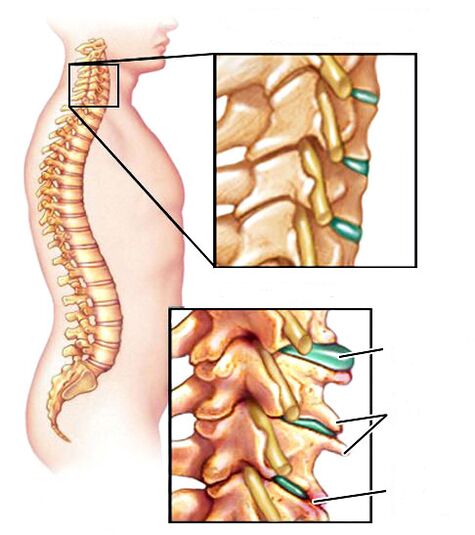
Long holding of the head in one position leads to severe pain.At this stage of the development of the disease, patients already come to the doctor for help.
Stage III
The fibrous ring in the disc is destroyed, hernias are formed.In the third stage there is deformity of the spine, displacement and dislocations of the vertebrae due to their poor fixation.Symptoms are as follows:
- Intense, acute neck pain, collar area, heart area;
- The sensitivity of the scalp on the back of the head, in the area of the shoulder, in the hands, until the complete absence of;
- hernia of the cervical spine;
- Paresis and paralysis of the upper limbs;
- Tensile reflexes are practically not observed.
This is a severe stage of the disease in which the patient is no longer able to support his head alone.Ischemia of the spinal cord and compression of the arteries of the spine lead to paralysis and paresis in other parts of the body and spinal stroke.
Non -specific and large number of different symptoms that accompany osteochondrosis of the cervical spine make it difficult to diagnose and further treat, as some of them may be a sign of completely different diseases.Symptoms of cervical osteochondrosis are formed in certain groups called syndromes.Their presence and weight can indicate pathology in the cervical spine with updated localization.
Clinical picture of osteochondrosis of the cervical spine - symptoms, signs
Osteochondrosis of the cervical region is a chronic, slowly progressive spinal disease, in which the vertebrae, intervertebral joints and discs are affected and destroyed.The vertebrae from the first to the seventh who belong to the cervical region suffer.
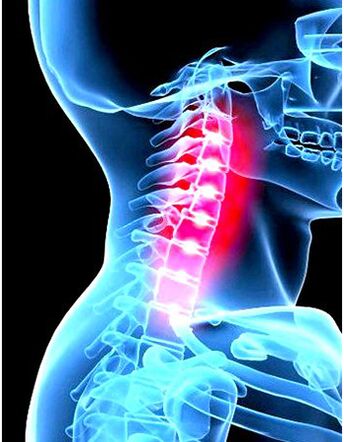
As the disease progresses, the intervertebral discs lose their elasticity and strength, flattened, relaxed, their shock absorbing properties worsen.Such deformation occurs due to changes caused by force disorders and tissue depletion.
These disorders are one of the natural processes of aging of the body, but various overloads, posture disorders, injuries, congenital anomalies of the spine, and some other causes cause early cartilage and discs.
The pain may have different localization, they can be in the neck, in the back, in the shoulder or upper limb.The pain in the shoulder or arm occurs when the spine of the nerves innervates the upper limb, involved in the process.Pain in the back of the head is caused by spasms of the neck muscles that are attached to the occipital bone and blood disorders in the area.
When symptoms appear:
- Reducing the sensitivity in the hand occurs when the spine is damaged, which contains sensitive nerves, innervating the skin of the upper limb.
- Restricting movements in the cervical spine and crunching during movement occurs due to a decrease in the height of the intervertebral disc, the appearance of bone growth on the bodies of the vertebrae and damage to the small joints between the cervical vertebrae.
- Dizziness, impaired coordination, weakness occurs in severe cases with severe worsening of the blood supply to the back of the brain, brain and trunk.
- Tingling tongue, hearing and vision reduction
All of these symptoms are due to the involvement of the spinal artery in the process, which takes place in its own channel, located in the transverse processes of the cervical vertebrae.As a result of the development of cervical osteochondrosis, the formation of fibrous tissue, the vertebrae of the vertebrae, the blood flow to these arteries worsens, leading to a deterioration of the blood supply to the back fraction of the brain and brain.
Reasons
- excessive physical activity in sports or heavy physical labor;
- hereditary predisposition;
- neck hypothermia (walking in winter without a scarf);
- stress;
- work on the computer;
- Obesity.
Some of the above causes cause osteochondrosis and other spine.
The degree of osteochondrosis is determined by the clinical picture and the patient's complaints.The concept of the degree should not be confused with the stages of osteochondrosis.The stages will be discussed below.
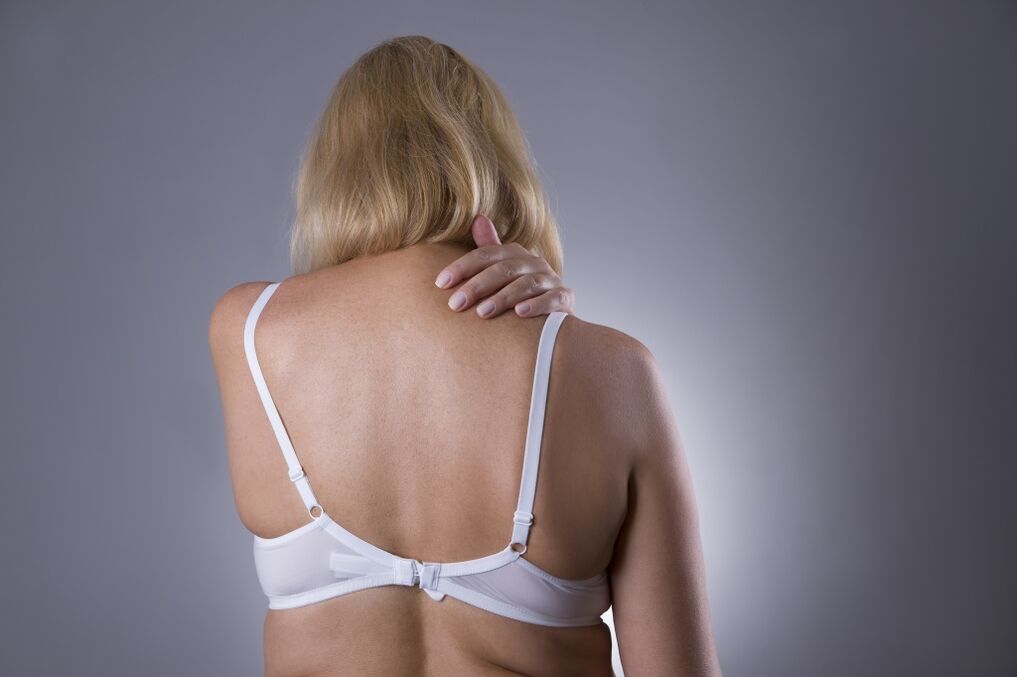
Given and analyze the procedure for the development of changes in the tissues of the vertebrae, doctors distinguish several stages of osteochondrosis of the cervical region:
- Preclinical phase.First -degree cervical osteochondrosis is expressed by displacing the pulpulated nucleus on the side and the beginning of the destruction of the fibrous ring.The pain during this period may be absent, a small lordosis and difficulty in rotating or tilting the head is possible.
- Osteochondrosis of the cervical region of the 2nd degree is characterized by an increase in pathological destruction, the instability of the entire segment with the subloxis and pain occurs, sometimes distributed in the shoulder belt or arm.The patient complains of dissipation, memory deterioration and attention.
- 3rd degree osteochondrosis develops with complete rupture of the fibrous ring.Neurological symptoms occur, sensitivity is impaired.The pain in the third stage becomes constant and greatly bothers the patient.The mobility of the cervical segment is deteriorating.
- Osteochondrosis of the neck 4 degrees.The last stage of the degenerative process.The intervertebral disc is completely replaced by connective tissue, all symptoms become more pronounced, and the deterioration in the coordination of movements is notxy.
Depending on the location of the pain, the following types of diseases are distinguished: radiculoichemia, cervicobrians, cervicocranial and cervical.
According to the method, of course, the disease is customary to divide into acute intervertebral osteochondrosis of the neck, which occurs for the first time and chronic, extending for years with constant remissions and exacerbations.
Which doctor treats cervical osteochondrosis?
The variety of symptoms often hides under the mask of another disease, causing patients a logical question - which doctor to contact?When any pain in the neck, shoulders and arms, or the onset of neurotic disorders, it is urgent to approach the neurologist or vertebologist.
And who to contact if there are no such specialists at the local clinic?In this case, the ticket must be postponed to the therapist.The doctor will prescribe treatment or send a close specialization to the doctor.
Symptoms depending on the damaged vertebrae
Radicular syndromes can be distinguished separately, leading to one or the other sensitive and motor disorders.They differ depending on what type of vertebra squeeze the spinal root:
- C1: leads to tingling and impaired sensitivity in the back of the head;
- C2: Pain in the parietal area and the back of the head;
- C3: speech damage, tongue sensitivity, pain and reduction of sensitivity in the country where the spinal nerve is impaired;
- C4: heart pain, left hypochondrium, shoulder, shoulder blade, respiratory disorders, decrease in the tone of the neck muscles;
- C5: shoulder pain in the outer area;
- C6: The pain that is given from the forearm to the thumb of the hand, as well as from the neck of the shoulder;
- C7: The pain in the back surface of the shoulder, from the neck to the shoulder, gives the forearm to 2-4 fingers of the arm;
- C8: Neck to shoulder, from the forearm to the little finger.
Diagnosis of osteochondrosis
In order to diagnose, instrumental examination methods are used:
- X -ray spinal examination;
- myelography;
- Neurological examination of sensitivity, reflexes.
Additional methods prescribed for differentiation and clarification of the diagnosis, the stage of the pathology includes:
- Computed tomography of the spine (CT);
- nuclear magnetic resonance (JAMR);
- Magnetic resonance imaging (MRI).
During the study with neurological tests, the doctor will evaluate the degree of mobility and soreness of the neck, as well as impaired blood flow to the spinal artery.
Cervical osteochondrosis requires not only the study of the vertebrae themselves, but also the nearby tissues, blood vessels, and nerves.Only then can we evaluate the complete picture of the pathological changes that have occurred due to illness.
The diagnosis of cervical osteochondrosis begins with a visual examination and examination of the patient.The neuropathologist is interested in the patient's living and labor conditions, the presence of chronic diseases, nutrition and motor activity.
Pre -diagnosis is confirmed by instrumental research:
- X in two projections;
- MRI;
- Ct;
- UZDS (duplex scan).
Hormone analysis is required for the more righteous sex.Without it, the treatment of cervical osteochondrosis in women does not begin.
To exclude pathologies with similar symptoms, a differential diagnosis is performed with the appointment of additional consultations with a surgeon, gynecologist, cardiologist, ophthalmologist and erudition.
Osteochondrosis complications
Osteochondrosis of the cervical spine is dangerous with its complications.With the adverse development of the disease, squeezing the spinal artery can lead to a stroke of the brain, a steady deterioration of hearing and vision.
Often intervertebral hernia, severe hypertension and numbness or cooling of the fingers join osteochondrosis.In women, complications of neurological nature often develop - constant fatigue, lethargy, loss of efficiency, excessive resentment.
Mismatch with prescribed treatment, prolonged avoidance of a doctor and the lack of osteochondrosis therapy contributes to the progression of the disease and provokes the development of complications, pathologies and new diseases, such as: for example:
- hernia of intervertebral discs (hernia of the spine);
- convexity;
- kyphosis;
- radiculitis;
- Salt deposits in the intervertebral space;
- Spinal cord stroke;
- reduction of muscle mass of the limbs, muscle atrophy due to impaired blood supply;
- Paralysis of the lower limbs.
Despite the fact that the fourth degree of osteochondrosis can occur without pronounced symptoms and pain, neglected osteochondrosis is the most dangerous for the development of serious complications and can lead to damage to the patient.
Medical physical education
LFK for cervical osteochondrosis should be performed out of acute exacerbation.The biggest efficiency of this technique during the recovery period.There should be no discomfort and pain during the application of the complex!
| Exercise Number 1 | Lying on your stomach, resting your hands on the floor, lifting your head and torso, your back should be right.Stay in this position for 1-2 minutes.Slowly sinks to the floor.Repeat 2-3 times. |
| Exercise number 2 | When lying on your stomach, stretch your arms on your body, turn your head to the left, try to touch the floor with your ear, then turn your head to the right.Repeat 6-7 times in each direction. |
| Exercise number 3 | In a sitting position, lean forward and try to touch your chest with your head, then exhale, lean back and throw your head.Repeat 10-15 times. |
| Exercise Number 4 | When sitting, place your palms on your forehead, put pressure on your palms on your forehead and your forehead is on your palm.Continue this exercise for 30 seconds.Repeat 2-3 times. |
| Exercise Number 5 | Slowly rotate your head first in one direction, then in the other direction.10 rotations in each direction.Make sure there is no dizziness.When it appears, the exercise stops. |
Risk factors
The chances of increasing osteochondrosis if you have:
- Abnormalities of spinal development;
- excess weight;
- Long exercise;
- bad habits (smoking);
- A sedentary lifestyle;
- a work that implies the regular impact of vibration on the spine (for example with vehicle drivers);
- long stress, excessive nervous tension;
- local hypothermia;
- Previous neck and back injuries;
- Autoimmune pathologies involving the degeneration of cartilage.
Psychosomatics
The development of cervical osteochondrosis indicates the inability to competently withstand problems.Sometimes people become so strong and confident in their abilities that their stability before discomfort is transformed into firmness and lack of flexibility.In this case, attempts to turn their heads are accompanied by stiffness, convulsions and other unpleasant sensations.
Also, osteochondrosis can develop in people who are afraid of problems and do not know how to deal with them.In this case, the protective reflex of the mammal is triggered and the head is literally drawn into the shoulders.Therefore, this provision is considered unnatural, after a while the muscles of the cervical region begin to ache and deform.
Treatment
The treatment of cervical osteochondrosis depends on the stage of the disease.If there is a sufficient conservative, wandering treatment in the first stage, then in the second and third stage the doctor's task is to stop the pain syndrome first.Improved cases may require surgical treatment intended for decompression and stabilization of vertebrae.
Medication
| Group | Description |
| NSAIDs (non -steroidal anti -inflammatory drugs) | Help eliminate swelling and pain.The basis of the most commonly used drugs is such active components as sodium diclofenac. |
| Vasodilative drugs | Contribute to improving blood circulation. |
| Soothing, muscle relaxants | They are further prescribed to facilitate the general condition of the patient and reduce the doses of NSAIDs.Relieve at the same time nervous surge and muscle cramps, help to achieve a better therapeutic effect. |
At the end of the course of the therapy, NSAIDs should be purchased for a home kit for the first time, as neck pain can periodically return (with stress, overvoltage, change of time).Consult your doctor before taking medication.
If no positive effect is observed after conservative treatment for conservative treatment, the doctor may recommend the patient's spinal fusia.
This procedure allows you to immobilize the affected spinal segment.
Its essence is to remove the intervertebral disc, decompression of the nerve root, install the implant or create the physiological height of the disk space.
The operation has many side effects and contraindications.So this can cause vertebrogenic damage.Therefore, the operation is performed in extreme cases.
Cervical osteochondrosis massage allows you to achieve noticeable improvements.It is important that the procedure be performed by a professional: the inadvertent movements in the cervical spine will worsen the situation.Movements should affect the area of the collar, cervical region and part of the back.
Take a look at the technique of performing exercises for the treatment of cervical osteochondrosage for osteochondrosis implies the alternation of the following actions.
- Gali.The massif affects the surface layers of the skin, passing from the head to the upper third of the middle of the back.At the same time, the palms or tip of the top work.
- Pressure.There are deep layers of skin, located in the upper third of the back.In this case, the index and thumb of the hands are performed through the neck to take the skin.Platoons adjacent to the vertebrae do not participate in this process.
- TRIPERATION.It is performed to warm the skin, increase blood flow to the collar.The procedure should be performed extremely carefully.It is forbidden to influence the spinous processes of the vertebrae.Sometimes rubbing is replaced with circular shocks or saws.
- Kneading.It affects deeply lying tissues, therefore it has limited value.It can worsen the pathology.
During the massage, the patient should lie on his stomach, in extreme cases, sit.
Prevention

To prevent the disease is recommended:
- For the health of the spine, it is important on which the pillow passes to sleep on an orthopedic pillow and mattress;
- Take a hot shower every day for 10 minutes;
- Visit a bath or sauna (relieve cramps of the neck muscles);
- Avoid sharp slopes and turns of the head;
- walk more on foot, do yoga and swimming;
- With "sitting" work, take five minutes of breaks every hour (you should walk during breaks, tilting with your body and head in different directions);
- Avoid increased spinal loading: classes with weights, jumps, running;
- Choose chairs and chairs that support the spine;
- abandonment of addictions such as smoking, alcohol abuse;
- Drink at least one and a half liters of water a day.
Nutrition with cervical osteochondrosis is often recommended (at least five times a day) and in small portions.Preference should be given to stewed or cooked meals.The salads should be seasoned with olive oil.

























